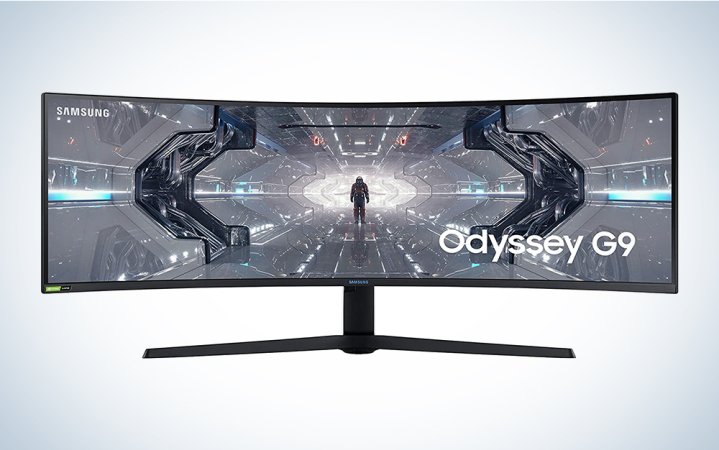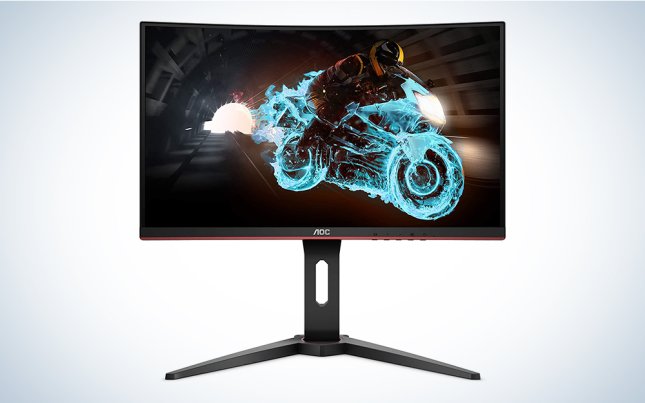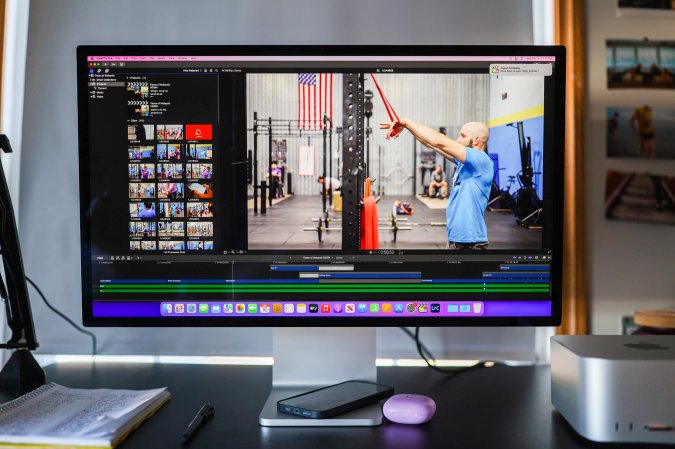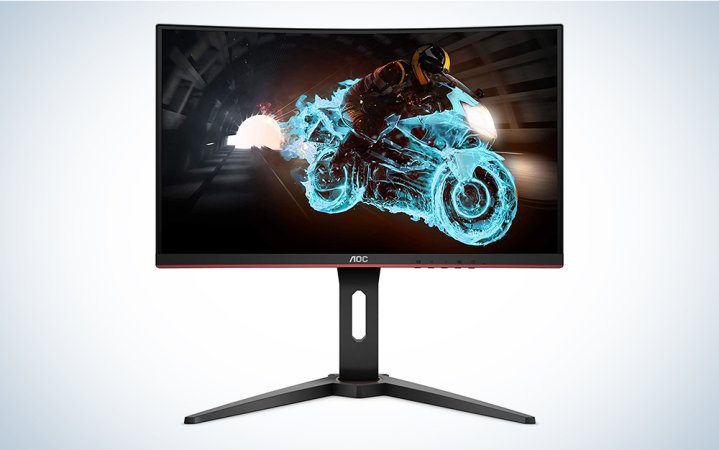We may earn revenue from the products available on this page and participate in affiliate programs. Learn more ›

Monitors for home offices have become essential pieces of the remote work lifestyle. We can even spend lunch hours and happy hours in front of them. The home office can transform a corner of the second bedroom into a conference room. An interface for coworkers, teachers, friends, and family, the right monitor in a work-from-home setup can be central to improving both our outlook and using Outlook. So let’s, well, screen options for the best monitors for home office.
- Best Overall: Dell Ultrasharp U2720QM
- Best 4K for gamers: LG UltraGear 27GN950-B Monitor
- Best ultrawide monitor: Samsung Odyssey G9 Monitor
- Best for Mac: Apple Studio Display
- Best USB-C: Dell S2722QC
- Best budget: AOC C24G1A Curved Frameless Monitor
How we chose the best monitors for home offices
We have home offices of our own here at PopSci, complete with standing desks and file cabinets. To find the best monitors for home offices, we referenced what we learned from past monitor coverage and applied it here. We also look at reviews, recommendations, performed hands-on testing, and did heavy research when narrowing down our choices.
The best monitors for home offices: Reviews & Recommendations
A 4K monitor for gaming is going to perform differently than one meant for office use. One of our choices will surely be a great addition to your office setup and still give you room to work and play. Just add a laptop or PC, ergonomic chair, ergonomic mouse, top-notch keyboard, and you’re in business.
Best 4K: Dell Ultrasharp U2720QM
The Sharper Image
Pros
- Size
- Resolution
- Port selection
Cons
- Lower refresh rate
- Price
Specs
- Size: 27-inches
- Resolution: 4K
- Ports: Two HDMI, two DisplayPorts, one USB-C, two USB-A, one headphone jack
- Refresh rate: 60Hz
If you’ve got to crunch the numbers, you shouldn’t have to squint to see them, and the Dell Ultrasharp U2720QM monitor for home office offers 27 inches of crisp 4K display space at a competitive price of about $600. The IPS (that’s In-Plane Switching) LED panel delivers a clearer picture from any angle, features 163 pixels per inch, and has a 1,300:1 contrast ratio (the more above 1,000 that the left number goes, the better). Plus, it offers 95 percent of the P3 gamut, which is the color space many of us have gotten used to watching video. The best Dell monitor for home office supports HDR, or high dynamic range, which means more visible detail, especially in the darker areas of the screen. So, even if the folks from accounting aren’t good about lighting their Zoom calls, you can see more of their faces. And, with USB-C, DisplayPort, and HDMI inputs, the U2720QM is ready to connect to pretty much any standard computer (and it can be used to charge and/or daisy chain USB-C devices).
Need something more specialized? Well, if you’re a video editor, you should check out the best monitors for color grading, while aspiring e-sports professionals can look through the best gaming monitors or read more below.
Best 4K for gamers: LG UltraGear 27GN950-B Monitor
Gaming the System
Pros
- High refresh rate
- Port selection
- Resolution
Cons
- Price
Specs
- Size: 27-inches
- Resolution: 4K
- Ports: Two HDMI, Two USB-A, one USB-B, a headphone jack, one DisplayPort
- Refresh rate: 144Hz
If a monitor is the window to a game’s soul, you don’t want to shortchange all the passion put into these immersive worlds, do you? With the right hardware support, the LG 27GN950-B’s “Nano IPS” panel can achieve a 144Hz refresh rate (overclocked to 160Hz) and 1ms response time, which is ridiculous for a 4K monitor. It is both G-SYNC and FreeSync—offering flexibility if you do decide to purchase a top-shelf graphics card—but is a solid performer with low input lag right out of the box, offering multiple calibration presets and customizable parameters. It’s a very bright monitor, which is great for fighting the glare of a workday with suboptimal lighting (though, conversely, it might not have the best contrast for dark-room gaming, where a VA panel is preferred). It’s not too terribly much more than an office-oriented 4K monitor, has all the standard ports (USB-C, HDMI, and DisplayPort), and is capable of delivering a clear, tearing-free experience whether shooting off emails or tearing through another campaign.
Not all monitors have to be a major investment, however, as the best cheap gaming monitors can attest.
Best ultrawide: Samsung Odyssey G9 Monitor
Widening Your Horizons

Pros
- Refresh rate
- Size
- HDR support
Cons
- May be too big
- Price
Specs
- Size: 49 inches
- Resolution: 5120 x 1440
- Ports: One HDMI port, two DisplayPorts, Three USB-A ports
- Refresh rate: 240Hz
The best Samsung monitor for truly voracious content consumers and creators, the Odyssey G9 offers an astounding 32:9 aspect ratio, driven by a company known for its pin-sharp panel innovations. Using QLED technology, this DQHD monitor features 5,120 by 1,440 resolution, a 240Hz refresh rate, and HDR10. It has a curvature of 1000R, which matches the human eye and keeps the entire image at the same distance to minimize eye strain, with great peak brightness and reflection handling perfect for those well-lit office appointments. There’s no doubt this represents the pinnacle of side-by-side document comparison, and a Picture-in-Picture feature lets multiple devices be displayed simultaneously. It’s also a monitor optimized for G-SYNC/FreeSync and the motion handling of gaming (making it one of our favorite ultrawide gaming monitors).
Best for Mac: Apple Studio Display
Best monitor with a webcam for Mac
All Apple Everything
Pros
- 5K display with fantastic color accuracy
- Deep sound from built-in speakers
- 12-megapixel webcam with Center Stage support
Cons
- Expensive
Buy it used or refurbished: eBay
Why it made the cut: It’s expensive and not without issues, but Apple’s Studio Display is an attainable 5K display with all the design flourishes you’d expect from an Apple product.
Specs
- Size: 27-inch
- Resolution: 5120 x 2880
- Ports: Thunderbolt 3/USB-C (96W), USB-C (3)
- Refresh rate: 60Hz
For Mac lovers, the new Apple Studio Display finally delivers on the promise of a high-end monitor made by Apple for its desktop fans and MacBook aficionados. It isn’t as performant as Apple’s premium Pro Display XDR, which costs upwards of $6,000. Still, you get a great 27-inch, 5K display with many quality-of-life features like a Thunderbolt 3 port that delivers 96W of power, three USB-C ports, and one of the best speaker systems you’ll find in a monitor.
The biggest benefit of using a computer and monitor designed by Apple is that the two work together within the company’s hardware ecosystem. The MacBook Pro we used while testing the display immediately recognized the monitor each time we connected the two. Additionally—and this is admittedly an aesthetic luxury rather than a necessity—its glass and aluminum body looks sharp on a desk. Similarly, we were caught off guard by the quality of the Studio Display’s speakers. Bass was punchy, with ample detail still in the mids and highs.
The only sticking point, beyond the monitor’s price, is the quality of its 12MP webcam. The issue is that the company opted to sacrifice overall visual fidelity for the sake of supporting a feature called Center Stage. This means the webcam will zoom in and crop its image to keep you in the middle of the frame. It’ll also pan around as you move around. This is a neat feature, but we’d have preferred a better-looking webcam.
Still, this is one of, if not the best, of the monitors you can get if you’re an Apple hardware fan outfitting your home office.
Best USB-C: Dell S2722QC
Pros
- 65W of USB Type-C Power Delivery means you can charge your laptop while you use it
- Sturdy Stand
- Rotation and height adjustment
Cons
- Response rate too low for gaming
Specs
- Size: 27-inch
- Resolution: 3840×2160 (4K)
- Ports: 2 x HDMI 2.0, 1 x USB Type-C, 2 x USB-A, 1 x headphone jack
- Max refresh rate: 60Hz
More and more computers are adopting USB-C or Thunderbolt ports, and if your computer is equipped with one, we strongly suggest checking out Dell’s S2722QC. In our tests, we found its build quality to be excellent—despite its frame being made from plastic—especially the sturdiness of its stand and foot. We could rotate the display by 90 degrees with nary a wobble. Critically, you can adjust this display’s height so you can find an ergonomic position to work in that won’t strain your neck.
Unsurprisingly, this monitor’s USB-C port is its best feature—our 13-inch MacBook Pro never had a problem connecting or charging—but it’s complemented by a pair of HDMI ports, a couple of USB-A ports, and a headphone jack. Those USB-A ports are useful if you decide to connect a webcam and external hard drive to your machine when you plug your laptop into this display.
Overall, we were pleased with the look of Dell’s S2722QC during everyday use. It was more than sufficient for tasks like reading articles, streaming video, and being a part of digital meetings. The display’s color accuracy was suitable for casual photo editing, but professionals are better off with a display that covers the entire sRGB color spectrum. On the other hand, the monitor’s 4K resolution made those photos, videos, and text we viewed look clear.
Our time with the Dell S2722QC shows just how far USB-C monitors have come recently. To get this level of performance from a display that’s this inexpensive is remarkable and proves the company’s commitment to pushing premium features in less expensive hardware.
Best budget: AOC C24G1A Curved Frameless Monitor
A Viewpoint on Value
Pros
- High refresh rate
- Freesync support
- Height adjustable
Cons
- May not be big enough
- Not high resolution enough for creative work
Specs
- Size: 24-inches
- Resolution: 1080P
- Ports:
- Refresh rate: 165Hz
An FHD display with up to a 165Hz refresh rate, the AOC C24G1A monitor features a 1,500R curved VA (Vertical Alignment) panel and 3,000:1 contrast ratio, meaning it will offer inky blacks and vivid colors. You won’t get the same color gamut as an IPS monitor, but you will get some added depth to the physical experience. The monitor’s frame is unobtrusive, and the sturdy stand has height, swivel, and tilt adjustments, offering a well-rounded, responsive experience. You’re restricted to using HDMI or DisplayPort as your connection, but the monitor still offers a lot of upscale, cinematic features for a low price and will improve the general work environment.
If your work involves travel or devices in multiple locations, another cheap option is the 15.6-inch Lepow HD USB-C display—the best portable monitor for mobile presentations. It’s not a replacement, more an extension of your desktop—think an iPad, minus everything but the screen. For just under $200, you get a 1080p IPS Eye Care panel with Mini-HDMI and USB-C ports (and a built-in cover) to connect a laptop, smartphone, or gaming device while on the go.
What to consider when shopping for the best monitors for home offices
Size
Naturally, the first spec you should consider when buying a monitor for your home office is its size. Most external monitors measure between 24 and 27 inches diagonally, which is roughly double the size of a 13-inch laptop display. This is a big enough canvas to make creating digital art or multitasking a lot easier. There are monitors above and below those sizes, too, depending on your needs.
Resolution
A monitor’s resolution will dictate how crisp text, images, videos, and games look, and its importance varies based on what you’re doing. A 1080P HD monitor is perfectly fine for gaming, but won’t cut it for high-resolution photo and video editing. Conversely, a 4K monitor is better for creative professionals but won’t be as important for gamers unless you plan on playing high-end titles at their maximum settings.
Ports
Most external monitors have both HDMI and DisplayPorts, which will allow you to connect a computer to it without the need for an adapter. Some monitors suited for home office use also have USB-C ports, which allow them to act like a hub for smaller accessories like a webcam or external hard drive.
Refresh Rate
This spec dictates how quickly the new information can update the screen. This is the most important feature to consider if you primarily plan on using the monitor for gaming. Every millisecond counts when playing games and can make the difference between winning and losing, so seeing your character move as quickly as possible will make a big difference.
FAQs
Start your search at 24-inch models, but seriously consider 27 inches as a best baseline. A Full HD (1080p) resolution is the bare minimum, but a 4K panel with more than 100 pixels per inch, flicker-free operation, more than 95 percent of color spaces, and low blue light will deliver the crisp, rich presentation that reduces frustration and fatigue. An adjustable, ergonomic stand will reduce slouching and straining. Having both an HDMI and a USB-C port will assure maximum compatibility. And if for some reason you want to mount a monitor to a wall, make sure to pick one that is VESA compatible for ease of attachment.
“Need” is a relative term. If you’re not doing photo or video editing, you probably don’t need a 4K monitor. But could even clerical work and conference calls benefit from the added resolution? Absolutely. And, as more and more streaming media sites upgrade their content to the standard, getting 4K is a way to partially future-proof your investment.
Eye strain, like carpal tunnel syndrome, is a harsh reality of the modern work environment, but it doesn’t have to be inevitable. To reduce the chance of fatigue, look for a monitor that promises flicker-free, low-blue-light technology. Several brands, such as BenQ, ASUS, and ViewSonic, designate optimized monitors as “Eye Care.” An adjustable, ergonomic stand and fast response rate also help, because the best solution is a consistently stable image.
In a word: Yes. Any monitor properly positioned at eye level will do wonders for your posture and efficiency compared to hunching over a laptop. But if you’re staring at something all day, go in for the rich color and sharpness that a 4K monitor delivers. The best monitors for home office offer the ability to display more simultaneously—cutting down on scrolling, clicking, and cursing as you cycle through buried documents—but more quantity needs to come with more clarity. At a resolution of 3840 by 2160, a 4K panel delivers four times the pixel count of HD (1920 by 1080) displays, which means more spreadsheet fields but also more pleasing video chats (you’ll see the pores on a nose before you’ll see the dots that make up the image).
You know what they say: work hard, display hard. OK, maybe that’s not a common saying yet, but it could be as PC gaming remains popular. While recognizing there are people who build a custom gaming rig and select a monitor specifically paired to their GPU, this recommendation is for the best gaming monitors for home office that can perform without dedicated NVIDIA or AMD hardware. You can really expect it to shine should you choose to invest in specialized components that can push its higher refresh rates and lower response times to the max. Just add a gaming mouse and keyboard and you’re headed up the leaderboard.
So you’re deeply embedded in the Apple ecosystem and looking for a monitor. Well, if brand loyalty and/or uniform aesthetics are a priority to you, that classic Cupertino industrial design is available in Apple’s own Studio Display, which costs $1,599. But if you’ve got a MacBook Pro, MacBook Air, or Mac mini from the last few years, you can access a USB-C port and any monitor supporting that connection. That makes the best Apple monitor simply the best USB-C monitor with the looks and features you like (pretty much any of our previous recommendations, though the Samsung would require an adapter). So, because many Mac users are creative professionals, this pick highlights a monitor geared toward color accuracy and photo/video editing.
This will depend on the size, resolution, and additional features for the monitor. You shouldn’t have to spend more than $150 to get a basic one, but could spend close to a grand if you want a premium one for gaming.
Final thoughts on the best monitors for home offices
- Best 4K: Dell Ultrasharp U2720QM
- Best 4K for gamers: LG UltraGear 27GN950-B Monitor
- Best ultrawide monitor: Samsung Odyssey G9 Monitor
- Best USB-C: Dell S2722QC
- Best for Mac: Apple Studio Display
- Best cheap monitor: AOC C24G1A Curved Frameless Monitor
Finding the best monitors for home office can take some time, but it’s worth it. Folks always talk about the benefits of investing in real estate. Well, the same goes for screen real estate. When it comes to a work-from-home setup, you may not always start with the optimal space, but if you approach selecting the best monitor for home office like the most cost-effective renovation, you’ll find one simple upgrade can substantially improve your workstation.








